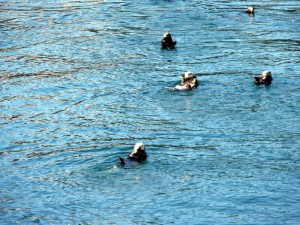Lamont-Doherty Earth Observatory160
-

Exploring the Bering Sea Ecosystem
Our stations have continued to be rich in phytoplankton, while our colleagues are excited by the larval fish they are finding in the southern Bering Sea. Wildlife sightings have included whales, dolphin, and the jawless lamprey fish, and we are settling in for potentially bumpy seas ahead.
-
Switchyard 2012: Climate Change in the Arctic
Arctic summer sea ice is declining rapidly: a trend with enormous implications for global weather and climate. Now in its eighth year, the multi-year Arctic Switchyard project is tracking the Arctic seascape to distinguish the effects of natural climate variability from human-induced climate change. The University of Washington is leading the project. A) The Canadian…
-

Diatoms and Dessert
The lovely spring weather in New York City as I prepared for this cruise was difficult to leave behind, and it will be nearly summer once we return. In the Bering Sea, it still feels like winter. For the past two days we have sampled water out on deck with snowflakes falling from the sky.
-

Why I Care About the Bottom of the Ocean
It is the middle of the night and I am wide awake thinking about the ocean, specifically the bottom of the ocean. Is it rocky? Jumbled? Smooth? Rocky is bad. Jumbled is bad. Smooth is good.
-

Clues to Sea Level Rise Are Hidden In and Below Greenland’s Ice
Greenland is surrounded by a ring of high mountains that work like fingers encircling the ice to hold it in place. Ice sliding from between these “fingers” into the surrounding waters results in a major human impact – Sea Level Rise.
-

Passing Through
The sun rose above the back decks this morning as we traveled towards Pavlof Bay for our station. As we made our way through the Aleutian Islands, the peaks of active volcanoes Mount Pavlof and Pavlof’s Sister became visible above the clouds. The Aleutians are part of the Pacific Ring of Fire, home to about…
-

New Book Teaches How to Think like a Geologist
Geologists really do see the world differently, whether it’s imagining the ancient processes that give rise to mountains or untangling the complexities that produce weather. A new book, co-edited by Lamont scientist Kim Kastens, explores the ways that geologists analyze and understand the earth system, and offers tips for those seeking to better understand it.
-

Fossil Teeth, Traces of Climate & Evolution
From fossil teeth to carbon traces of plants in the soil, scientists are studying how changes in climate may have influenced early human evolution in Africa. Researchers from around the world gathered for a symposium held recently at the Lamont-Doherty Earth Observatory. Watch the videos.
-

Plankton Fishing in the Bering Sea
As Discovery Channel fans know, the Bering Sea supports one of the world’s most productive fisheries, accounting for more than 50 percent of U.S. fish and shellfish catches. The goal of our study is to understand how climate change is impacting phytoplankton, and ultimately the Bering Sea ecosystem.

AGU25, the premier Earth and space science conference, takes place December 15-19, 2025 in New Orleans, Louisiana. This year’s theme—Where Science Connects Us—puts in focus how science depends on connection, from the lab to the field to the ballot box. Once again, Lamont-Doherty Earth Observatory and Columbia Climate School scientists, experts, students, and educators are playing an active role, sharing our research and helping shape the future of our planet. #AGU25 Learn More
